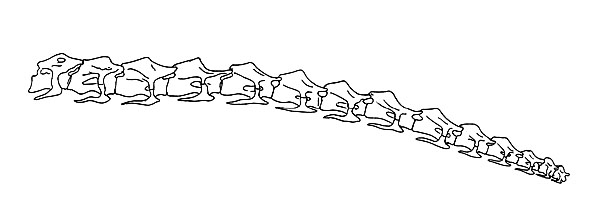
Species: lentus MARSH, 1890
Etymology: Latin, lentus, "tough."
Holotype: YPM 429
Locality: Piedmont Butte Quarry, Black Hills, 1 1/2 miles East of Piedmont, Meade County, South Dakota.
Horizon: Member? Morrison Formation.
Biostratigraphy: Zone?
Age: Age?, Stage?, Malm Epoch, Late Jurassic.
Material: 4 cervical, 6 dorsals, and 19 caudal vertebrae, sacrum, 1 sternal
plate, 1 scapula, ilium, pubis, ischium, fragments of femur, tibia and fibula.
Note: Gastroliths were found with the specimen.

Referred material:
FOSTER & MARTIN, 1994
Locality: V9139, lies south of Sundance in southern Crook County, Northeastern Wyoming.
Horizon: Member? Morrison Formation.
Biostratigraphy: Zone?
Age: Age?, Stage?, Malm Epoch, Late Jurassic.
Material:
SDSM 25331: 7 and 11 and fragments of 3 other caudal vertebrae of a juvenile.
FORSTER, 1996
SDSM 25210: Dorsals 7? And 8?, Caudals 1-7, 9, 10, 12-15, 19 and 21, Dorsal neural spine fragment, sacral neural spine fragment, 7 caudal neural spine fragments, 4 chevrons, partial right scapula, coracoid, pubis, ischium, partial ilium and many fragments.
GILMORE, 1932Locality: Quarry face as exposed inside the Dinosaur National Monument Visitor Center, Carnegie Quarry, Vernal, Uintah County, Utah.
Horizon: Brushy Basin Member, Morrison Formation.
Biostratigraphy: Zone 3.
Age: Upper Part, Comobluffian age, Kimmeridgian Stage, Uppermost Malm Epoch, Late Jurassic.
Material:
CM 340: Cervicals 1-10, dorsals 1-10, 3 sacral, and 4 caudals, scapula, humerus, ilium.
McINTOSH, 1981
CM 11984 (DNM 310): Articulated series of presacral vertebrae extending from the anterior part of neck to mid-dorsal region, several ribs.
CM 1198 (DNM 150/B): An associated series of cervical vertebrae. 10 cervical were collected but only 4 were sufficiently well persevered to be saved. the trunk, sacrum, and tail found in association of the neck were originally thought to belong to Diplodocus and were given a separate field number (DNM 155) latter specimen was transferred to the Royal Ontario Museum in Toronto (ROM 3670). some of the limb bones numbered 155 may belong to this specimen, but many do not. 1 caudal each transferred to North Carolina Museum, University of Texas and University of Cincinnati.
CM 21744 (DNM 312): Distal half of humerus, radius, ulna and most of manus of an articulated right forelimb, not improbably belonging to this genus.
CM 33978 (DNM 155/C, incorrectly labeled 150/C): Anterior half of left ilium and head of left pubis perhaps belonging to same individual as CM 1198.
CM 21719 (DNM 155/Hum 2): Right humerus which lay close to the neck of CM 1198 and was assigned the same number as the Toronto Specimen. but would appear to be too long to go with it.
CM 11878 (DNM 347): Postmedian caudal vertebra and upper ends of tibia and femur. The caudals have been transferred to the University of Michigan (V 16778).
MEYERS & HOOPS, 1993
DINO 4948: Cervical vertebra.
McINTOSH, 2005
AMNH 6341: Cervicals 10-16 (?), dorsals 1-9, sacrals 1-5, caudals 1-29, 6 ribs and fragments, 1 chevron, complete pelvis, left scapula-coracoid and part of right scapula, left humerus, right hindlimb and part of pes.
ROTHSCHILD & MOLNAR, 2005
DINO 874: Metatarsal II.
Note: Has a tendon calcification-exostoses, pathology.
STOKES
Locality: Cleveland-Lloyd Dinosaur Quarry, approximately 20 miles south of Price, SE 1/4, SE 1/4, Sec. 21, T17S, R11E, SLBM. lat 39°19’00", Long. 110°41’15"W, San Rafael Swell Area, Carbon County, Utah.Horizon: Brushy Basin Member, Morrison Formation.
Biostratigraphy: Zone 3.
Age: Upper Part, Comobluffian age, Kimmeridgian Stage, Uppermost Malm Epoch, Late Jurassic.
Material:
Number: Not given:
= Barosaurus affinis MARSH, 1899 (nomen dubium)
Etymology: Latin, affinis, "neighboring, allied to, kindred."Holotype: YPM 419
Locality: Margin of Black Hills, South Dakota.
Horizon: Member? Morrison Formation.
Biostratigraphy: Zone?
Age: Age?, Stage?, Malm Epoch, Late Jurassic.
Material: Metacarpals I and II of the left manus.